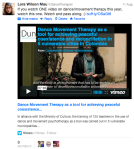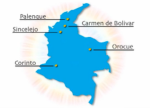Let me put my cards on the table.
I started this blog two years ago out of a deeply felt frustration that I know is shared by many of my fellow dance/movement therapists. I know they share this frustration in some form or another because the topic and the discussion of ways to address it has been repeated – for years – in professional discussions, online forums and local and national dialogues. It is an ongoing issue for our professional community.
The frustration is this:
In the 21st century, how can it be that the profession of dance/movement therapy is not better known? Better understood? At the very least, heard of? Granted, if one is not working in the mental health or rehabilitation or wellness professions, then it is perhaps logical that the profession be an unfamiliar concept. Certainly, I have never heard of countless occupations. But, how can it be in the 21st century, over ten years since the “Decade of the Brain” concluded, that dance/movement therapy is not better understood by our colleagues whose professions involve psychology or neuroscience?
How is it that when one googles “dance therapy” on the internet, one gets more references to Brittany Spears and pole dancing or random dance classes than one gets legitimate information on the nearly 50 year old profession of dance/movement therapy?
This latest spike in frustration was inspired by the recent feature on Anderson Cooper 360 that took a close look at a day in the life of Gabrielle Gifford’s rehabilitation at the TIRR Memorial Hermann Hospital in Texas.
How is it that when Dr. Sanjay Gupta visited the hospital to get a hands on experience of a day in the life of Congresswoman Giffords’ recovery, dance/movement therapy was not included in the diverse list of therapies? Yes, music therapy was on the day’s agenda and, to Dr. Gupta’s credit, he really appreciated the power of music therapy to work “on developing … attention, memory and overall executive function.” This acknowledgement on a show as respected and widely viewed as CNN’s Anderson Cooper 360 is a real boost for our colleagues in the music therapy profession.
But dance/movement therapy was NOT on the schedule and it was not addressed by Dr. Gupta – by name. However, a quick glimpse at the video of the music therapist, Maegan Morrow, reveals that she was incorporating movement with the music to help her patients improve cognitively and learn to walk again. “Lean 2, 3, 4, Push up, 2, 3, 4…” The diverse therapies at TIRR Memorial Hermann Hospital work together to rehabilitate patients from traumatic injury… and yet the experts on using movement psychotherapeutically, who are specifically trained in connecting through movement and facilitating movement and rhythm – for whatever end goal – are not on that team?
“The brain learns best when it processes cognitive, affective and psychomotor information simultaneously.” (emphasis mine.)
Dr. Michael Merzenich
Neuroscientist
This is fundamental knowledge to neuroscientists and to anyone familiar with “brain-based learning.”
Movement is not only integral to healing psychologically, it is integral to effective rehabilitation of the brain, to learning and to brain plasticity.
Though my peers and I ask these questions – how, how, how can the world not know? – we do so, of course, acknowledging the onus is on us, the dance/movement therapists. This is precisely why I blog on DMT, why I encourage my colleagues to do the same and why I am writing a book on the topics of this blog.
Did you know:
Neuroscientists have declared the importance of psychomotor processing to learning.
The New England Journal of Medicine published that dancing, moreso than any other leisure activity, decreases cognitive decline in senior citizens over 75.
Physical therapists have published repeatedly on the therapeutic value of dancing the tango for people with Parkinson’s disease.
These are but drops in the bucket of research that RIGHT THIS VERY MOMENT reveal the importance of dance and movement in our lives and yet… the official profession of dance/movement therapy remains in the shadows.
Compared to the combined fields that make up verbal psychotherapies (social workers, marriage and family therapists, psychologists, counselors, psychiatrists) – and even to our allied creative art therapists – dance/movement therapists are still very small in number. We practice in countries all over the world but only have seven graduate programs in the United States where the dance/movement therapy master’s degree can be earned. There are additional ADTA approved “alternate route” programs for individuals who have a master’s degree in a related mental health field to get the requisite DMT training; even so, a handful of programs can only produce so many dance/movement therapists a year.
The simple fact of the matter is that at the Evolution of Psychotherapy Conference in Anaheim, California in 2009, the leading psychologists and psychiatrists in the world presented, among other things, on the importance of acknowledging the body in psychotherapy: attending to bodily sensation, breathwork, moving, mindfulness, meditating. The handful of respected dance/movement therapists that attended with me sat, nodding, in agreement. Yes. Yes, we know. This is what we do. This is what we have done for over forty years.
The simple fact of the matter is that 10 million people worldwide are participating in Zumba® classes each week, many referring to it as their “therapy.” Television news stations are doing stories on the effect of Zumba® on its students and teachers alike, noting its therapeutic value in places as unusual as prisons. Again, though Zumba® is a fitness class and not dance/movement therapy, the fact that dancing is experienced as being “therapeutic,” even within the structure of an exercise class, comes as no surprise to those in our profession.
The world is discovering in its own ways that movement and dance and the bodymind connection are important. This is wonderful! This growing awareness should be shining an ever-expanding spotlight on the profession that has been implementing these truths in its clinical practice for decades. Dance/movement therapists have not just discovered the power of movement to evoke emotion… or heal trauma… or break through isolation… or express that which cannot be spoken… or garner insight… or connect with self, with others. Dance/movment therapists have an extensive body of research and theory that delves deeply into these subjects. Our expertise can be your expertise… if the dialogue begins.
We must be on the edge of a fusion, of an integration, of a collaboration between verbal psychotherapies, neuroscience, medicine and dance/movement therapy that will change the course of healing and wellness and recovery in this new century. We must be on that edge. I can feel it.
But the awareness has to spread so that the curiosity can pique and the collaborations can begin large scale.
Dance/movement therapy must go viral.
That is my challenge to you. Help spread awareness. The research and the experts are there to back it all up. What is needed is awareness.
How I wish the media would shed light – BIG LIGHT – on these stories – or simply look in their own communities for the stories that are happening there, right now:
Dance/movement therapists making breakthroughs with children with autism.
Dance/movement therapists teaching staff and caregivers essential nonverbal communication skills to more meaningfully connect with those with dementia and Alzheimer’s.
Dance/movement therapists empowering women in India who are survivors of human trafficking and sexual abuse.
A Dance/movement therapist helping child soldiers in Sierra Leone feel empathy again – and teaching others how to continue the work in their communities through dance.
A dance/movement therapist who has designed a movement based curriculum to help foster empathy and prevent violence in schools.
There is not enough light cast on this work nor on its potential to effect real change in the lives of millions of people across the globe.
Help shine the light.
If your life or the life of someone you love has been touched by Alzheimer’s, autism, bullying, cancer, trauma, Parkinson’s, mental illness, an eating disorder, body image issues, brain injury… if you have ever felt the power of dance in your own life, on some level, please pass this on.
Shine the light.
This is a “virus” the world desperately needs.
Read Full Post »



